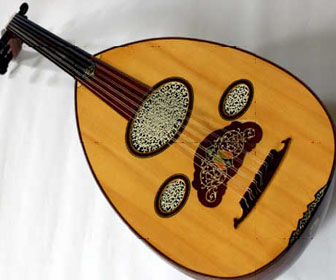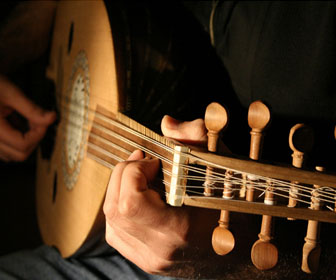 |
 |
| |
|
| |
UD | Turkish Folk Instruments

|
| |
 |

|
|
| |
|
|
| |
The Ud is the core of all Middle East music. Thus, it is the core of
makam based music. Most of the pitch theories are explained using
the ud. Besides that it is also used in Greek, Byzantine and, North
African music. It is a large-bodied instrument with a short neck
(pear shaped), belonging to the lute family. It does not have frets,
unlike the lute, & is considered as the ancestor of guitar. It is
played in Armenia and Iran and the entire Arab world including
Tunisia,Algeria and, Morocco.
Ud is one of the oldest stringed instruments. Its origin is
traced back to Ancient Egypt. according to Farabi, Adam's sixth
grandson, Lamech invented it. History says that when Lamech's son
died, he hung his son's body from a tree, and the shape of the dead
bleached skeleton, inspired the shape of the Ud.
The Turkish people initially had an instrument called Kopoz, which
was used in military bands and was brought to war. The present day
Ud is derieved from it.
The Ud is pear shaped with a short neck and it lacks frets.
This characteristic makes it suitable for playing all the complex
pitch scales of the makams. The Ud has 5 double strings & 1 isolated
string (single) at the end. The double strings are tuned as A3, B2,
D3 E3, F#2. The isolated string (Bam) is tuned to D2 or C#2. Tuning
is a big problem in Ud and there is little agreement among the
musiologists. The Ud is played using a plastic plectrum.
The strings are usually made of nylon and are played with a
plectrum.The Ud has a warm timbre and is intricately decorated. The
Turkish Ud has a brighter tone thanthe Arabic counterpart
The Ud is an instrument which has surpassed allinstruments of
its category. It is called the father of Arabic instruments and has
an crucial role in oriental orchestra, where accompanies teh singers
and the musicians.
|
|
| |
|
|
| |
|
|
| |
Other Turkish Instruments:
Baglama
 Classic Kemence
Classic Kemence
 Karadeniz Kemence
Karadeniz Kemence
 Tar
Tar
 Kanun
Kanun
 Darbuka
Darbuka
 Tambur
Tambur
 Ud
Ud
 Zurna
Zurna
 Ney
Ney
 Tulum
Tulum
|
|
| |
|
|
|
<-Back
|
|
 |
|
